2017 年山东青岛大学基础英语考研真题
PART I SENTENCE COMPLETION (20 points)
Choose the word or the set of words that, when inserted in the sentence, best fits
the meaning of the sentence as a whole.
1. House repairs , holidays, school fees and other _______ have reduced his bank
balance to almost nothing.
A. amount
B. payment
C. expenses
D. figures
2. The additional work will take _____ weeks.
A. the other
B. another two
C. other two
D. the more
3. The boys in the dorm _____ a coin to decide who would clean the floor.
A. held
B. tossed
C. put
D. collected
4. The patterns of spoken language are _____ from those of writing.
A.distinct
B. distinctive
C. Distinguished
D. distinguishing
5. The product contains no ______ colors, flavors, or preservatives.
A. fake
B. artificial
C. false
D. wrong
6. The police department came under strong criticism for both the death of an unarmed
man and its handling of the _______.
A. consequence
B. outcome
C. result
D. aftermath
7. It is said that Da Vinci is a versatile man who was good at many things. The
underlined word means:
A. changeable
B. competent
C. adaptable
�
D. omnipotent
8. Forecasting methods and techniques are equally _____ to all sectors of the
economy.
A. appreciable
B. applicable
C. attributive
D. Attractable
9.When Columbus embarked _____ his historical voyage, he never imagined that the
world history would enter into a new era.
A. upon
B. In
C. at
D. to
10.Years of civil war have wrecked the country’s infrastructure and destroyed
its social ____.
A. tissue
B. organ
C. fabric
D. construction
11. Israel and Hamas had reached a deal on extending the ______ ceasefire by
an extra 24 hours until Tuesday at midnight.
A. contemporary
B. makeshift
C. spontaneous
D. temporary
12. American culture now stigmatizes, and sometimes even heavily _______
behavior that was once taken for granted: overt racism, cigarette smoking,
the use of sexual stereotypes.
A. penalizes
B. advocates
C. ignores
D. advertises
13. Psychologists have done extensive studies on how well patients _______
with doctors’ orders.
A. comply
B. correspond
C. interfere
D. interact
14. It is not so much the language ___ the cultural background that makes the
book difficult to understand.
A. but
B. nor
C. as
D. like
�
15. By putting the entire Woolf archive on a microfilm, the project directors
hope to make the contents of manuscripts more ____________ to scholars.
A. objective
B. accessible
C. appealing
D. implicit
16. Advances in health care have lengthened life spans, lowered infant
mortality rates, and thus ________ the overpopulation problem.
A. eliminated
B. aggravated
C. minimized
D. distorted
17. The police managed to _________ the angry crowd.
A. provoke
B. stimulate
C. subdue
D. relax
18. Monica says she's looking forward to expanding her public and private
client base through her with Noctor.
A. companion
B. company
C. friend
D. alliance
19. One of the largest companies in the world will be a new product in Zambia tomorrow
A. issuing
B. showing
C. demonstrating
D. launching
20. As a heritage trail, the park includes a network of major cultural , principal
monuments, historic sites and open spaces.
A. landmarks
B. houses
C. cabins
D. places
PART II PROOF READING AND ERROR CORRECTION (10 Points)
The following passage contains TEN errors. Each line contains a maximum of ONE error.
In each case, only ONE word is involved. You should proofread the passage and correct
it in the following way.
For a wrong word, underline the wrong word and write the correct one in the blank
provided at the end of the line.
For a missing word, mark the position of the missing word with a “∧” sign and
write the word you believe to be missing in the blank provided at the end of the
line.
�
For an unnecessary word cross out the unnecessary word with a slash “/”and put
the word in the blank provided at the end of the line.
The richness of our language is considered by many to be the distinctive achievement
in human evolution. Language provides us for the means to communicate ideas, emotions
and (1) ____
knowledge and express our cultural identity. In Europe different languages are a
fact of life. The European Union considers the diversity of tongues as an inalienable
component of our cultural heritage; but (2) ____
the principle of language equality is present in Europe’s founding treaties.
Preserving linguistic diversity has been at heart of its olicy(3)____
from the very beginning. However, linguistic diversity demands a sustain and
substantial investment. For example, the European (4) ____
institution spend considerable portions of their operational budgets on translation
and interpretation services. For European industry and business language diversity
is a challenge or an asset , as the (5)____
Commission has recently pointed out in its first Communication ever
on a new strategic framework for multilingualism. What is sure that (6)____
early investment in multilingual communication technologies can
provide rapid access to new and emerging markets anywhere in the world--the factor
that is vital for the long-run success of Europe. The (7)____
ability to access and use informati0n across the languages is vital for (8)____
technologies can play an important role for enabling easy (9)_____
communication between people, administrations and businesses. The European Union,
in collaboration with the Member States, have sponsored over the last 20 years
several R &D actions which (10)____
have contributed to building expertise resources and a pan-European language
infrastructure.
PART III READING COMPREHENSION (40 Points)
Read the passages and then write your answers on your answer sheet.
Passage1
It is evident that there is a close connection between the capacity to use language
and the capacities covered by the verb “to think”. Indeed, some writers have
identified thinking with using words: Plato coined the saying “ In thinking the
soul is talking to itself”; J.B Watson reduced thinking to inhibited speech located
in the minute movements or tensions of the physiological mechanism involved in
speaking; and although Ryle is careful to point out that there are many senses in
which a person is said to think in which words are not in evidence, he has also said
that saying something in a specific frame of mind is thinking a thought.
Is thinking reducible to, or dependent upon, language habits? It would seem that
many thinking situations are hardly distinguishable from the skillful use of
language, although there are some others in which language is not involved,
Thought cannot be simply identified with using language. It may be the case, of course,
that the non-linguistic skills involved in thought can only be acquired and developed
if the learner is able to use and understand language.
�
However, this question is one which we cannot hope to answer in this book.
Obviously being able to use language makes for a considerable development in all
one’s capacities but how precisely this comes about we cannot say.
At the common-sense level it appears that there is often a distinction between
thought and the words we employ to communicate with other people.
We often have to struggle hard to find words to capture what our thinking has already
grasped, and when we do find words we sometimes feel that they fail to do their job
properly. Again when we report or describe our thinking to other people we do not
merely report unspoken words and sentences. Such sentences do not always occur in
thinking, and when they do they are merged with vague imagery and the hint of
unconscious or subliminal (下意识的)activities going on just out of rage. Thinking,
as it happens, is more like struggling , striving, or searching for something than
it is like talking or reading.
Again the study of speech disorders due to brain injury disease suggests that
patients can think without having adequate control over their language. Some
patients, for example, fail to find the names of object presented to them and are
unable to describe simple events which they witness; they even find it difficult
to interpret long written notices. But they succeed in playing games of chess or
draughts. They can use the concepts needed for chess playing or draught playing but
are unable to use many of the concepts in ordinary language. How they manage to do
this we do not know. Presumably human beings have various capacities for thinking
situations which are likewise independent of language.
1. According to the theory of “thought” devised by J.B Watson, thinking is ____.
A. talking to the soul
B. suppressed speech
C. speaking non-verbally
D. a non-linguistic behavior
2. What does the author think about the relationship between language and
hinking ?
A. The ability to use language enhances one’s capacity of thinking.
B. Words and thinking match more often than not.
C. Thinking never goes without language.
D. Language and thinking are generally distinguishable.
3.According to the author, when we intend to describe our thoughts, we ____.
A. merely report internal speech
B. have to search for proper words in the way we read
C. are overwhelmed with vague imagery
D. sometimes are not able to find appropriate words
4. Why are patients with speech disorders able to think without having
adequate control of language?
A. They use different concepts
B. They do not think linguistically.
C. It still remains an unsolved mystery
D. Thinking is independent of language.
�
5. This passage is an excerpt from ______.
A. a scholarly book
B. a text book.
C. a book report
C.an encyclopedia
Passage 2
Why do so many Americans distrust what they read in their newspapers?
The American Society of Newspaper Editors is trying to answer this painful question.
The organization is deep into a long self-analysis known as the journalism
credibility project.
Sad to say, this project has turned out to be mostly low-level findings about factual
errors and spelling and grammar mistakes, combined with lots of head-scratching
puzzlement about what in the world those readers really want But the sources of
distrust go way deeper. Most journalists learn to see the world through a set of
standard templates (patterns) into which they plug each day’s events. In other words,
there is a conventional story line in the newsroom culture that provides a backbone
and a ready-made narrative structure for otherwise confusing news.
There exists a social and cultural disconnect between journalists and their readers,
which helps explain why the “standard templates” of the newsroom seem alien to
many readers. In a recent survey, questionnaires were sent to reporters in five
middle-size cities around the country, plus one large metropolitan area. Then
residents in these communities were phoned at random and asked the same questions.
Replies show that compared with other Americans, journalists are more likely to live
in upscale neighborhoods, have maids, own Mercedes, and trade stocks, and they are
less likely to go to church, do volunteer work, or put down roots in community.
Reporters tend to be part of a broadly defined social and cultural elite, so their
work tends to reflect the conventional values of this elite. The astonishing distrust
of the news media isn’t rooted in inaccuracy or poor reportorial skills but in the
daily clash of world views between reporters and their readers.
This is an explosive situation for any industry, particularly a declining one.
Here is a troubled business that keeps hiring employees whose attitudes vastly annoy
the customers. Then it sponsors lots of symposium and a credibility project dedicated
to wondering why customers are annoyed and and fleeing in large numbers. But it never
seems to get around to noticing the cultural and class biases that so many former
buyers are complaining about. If it did, it would open up its diversity program,
now focused narrowly on race and gender, and look for reporters who differ broadly
by outlook, values, education, and class.
6. What is the passage about ?
A. Needs of the readers all over the world.
B. Causes of the public disappointment about newspapers.
C. Origins of the declining newspaper industry. D. Aims of a journalism credibility
project. 7. The result of the journalism credibility project turned out to be
___________.
A. quite trustworthy
�
B. somewhat contradictory
C. very illuminating
D. Rather superficial
8. The basic problem of journalists as pointed out by the writer lies in their _____
A. working attitude
B. conventional lifestyle
C. world outlook
D. Educational background
9. Despite its efforts, the newspaper industry still cannot satisfy the readers owing
to its____________.
A. failure to realize its real problem
B. tendency to hire annoying reporters
C. likeliness to do inaccurate reporting
D. prejudice in matters of race and gender
10. According to the text, which kind of journalists world be mot beneficial to the
development of newspapers nowadays?
A. Those from different races and gender.
B. Those with high reportorial skills.
C. Those deep rooted in the public.
D. Those with diverse world-views.
Passage 3
Read the following passage and answer the four questions. This passage is adapted
from Ethan Frome, a novel published in 1911 bythe American Pulitzer-prize winning
author Edith Wharton. Mattie Silver isEthan’s household employee.
Mattie Silver had lived under Ethan’s roof for a year, and from early morning till
they met at supper he had frequent chances of seeing her; but no moments in her company
were comparable to those when, her arm in his, and her light step flying to keep
time with his long stride, they walked back
through the night to the farm. He had taken to the girl from the first day, when
he had driven over to the Flats to meet her, and she had smiled and waved to him
from the train, crying out, “You must be Ethan!” as she jumped down with her bundles,
while he reflected, looking over her slight person:“She don’t look much on housework,
but she ain’t a fretter, anyhow.” But it was not only that the coming to his house
of a bit of hopeful young life was like the lighting of a fire on a cold hearth.
The girl was more than the bright serviceable creature he had thought her. She had
an eye to see and an ear to hear: he could show her things and tell her things, and
taste the bliss of feeling that all he imparted left long reverberations and echoes
he could wake at will.
It was during their night walks back to the farm that he felt most intensely the
sweetness of this communion. He had always been more sensitive than the people about
him to the appeal of natural beauty. His unfinished studies had given form to this
sensibility and even in his unhappiest moments field and sky spoke to him with a
deep and powerful persuasion. But hitherto the emotion had remained in him as a silent
ache, veiling with sadness the beauty that evoked it. He did not even know whether
�
any one else in the world felt as he did, or whether he was the sole victim of this
mournful privilege. Then he learned that one other spirit had trembled with the same
touch of wonder: that at his side, living under his roof and eating his bread, was
a creature to whom he could say: “That’s Orion down yonder; the big fellow to the
right is
Aldebaran, and the bunch of little ones—like bees swarming—they’re the
Pleiades...” or whom he could hold entranced before a ledge of granite thrusting
up through the fern while he unrolled the huge panorama of the ice age, and the long
dim stretches of succeeding time. The fact that admiration for his learning mingled
with Mattie’s wonder at what he taught was not the least part of his pleasure. And
there were other sensations, less definable but more exquisite, which drew them
together with a shock of silent joy: the cold red of sunset behind winter hills,
the flight of cloud-flocks over slopes of
golden stubble, or the intensely blue shadows of hemlocks on sunlit snow. When she
said to him once: “It looks just as if it was painted!” it seemed to Ethan that
the art of definition could go no farther, and that words had at last been found
to utter his secret soul.... As he stood in the darkness outside the church these
memories came back with the poignancy of vanished things. Watching Mattie whirl down
the floor from hand to hand he wondered how he could ever have thought that his dull
talk interested her. To him, who was never gay but in her presence, her gaiety seemed
plain proof of indifference. The face she lifted to her dancers was the same which,
when she saw him, always looked like a window that has caught the sunset. He even
noticed two or three gestures which, in his fatuity, he hadthought she kept for him:
a way of throwing her head back when she was
amused, as if to taste her laugh before she let it out, and a trick of sinking her
lids slowly when anything charmed or moved her. 1. Describe how the main focus of
the narrative shifts over the course of the
passage. 2. Analyze the characters of Ethan and Mattie using the evidence from the
passage. 3. Why does the author include the descriptions of the sunset, the clouds,
and
the hemlock shadows in the passage?
4. Based on the passage, how do you think Ethan and Mattie’s relationship
will evolve and why ?
PART IV TRANSLATION FROM ENGLISH INTO CHINESE (40
Points)
To the untutored ear, the Beijing dialect can sound like someone talking
with a mouthful of marbles, inspiring numerous parodies and viral videos. Its
colorful vocabulary and distinctive pronunciation have inspired traditional
performance arts such as cross-talk, a form of comic dialogue, and “kuaibanr,”
storytelling accompanied by bamboo clappers. But the Beijing dialect is disappearing,
a victim of language standardization
in schools and offices, urban redevelopment and migration. In 2013, officials
and academics in the Chinese capital began a project to record the dialect’s
remaining speakers before it fades away completely. The material is to be
�
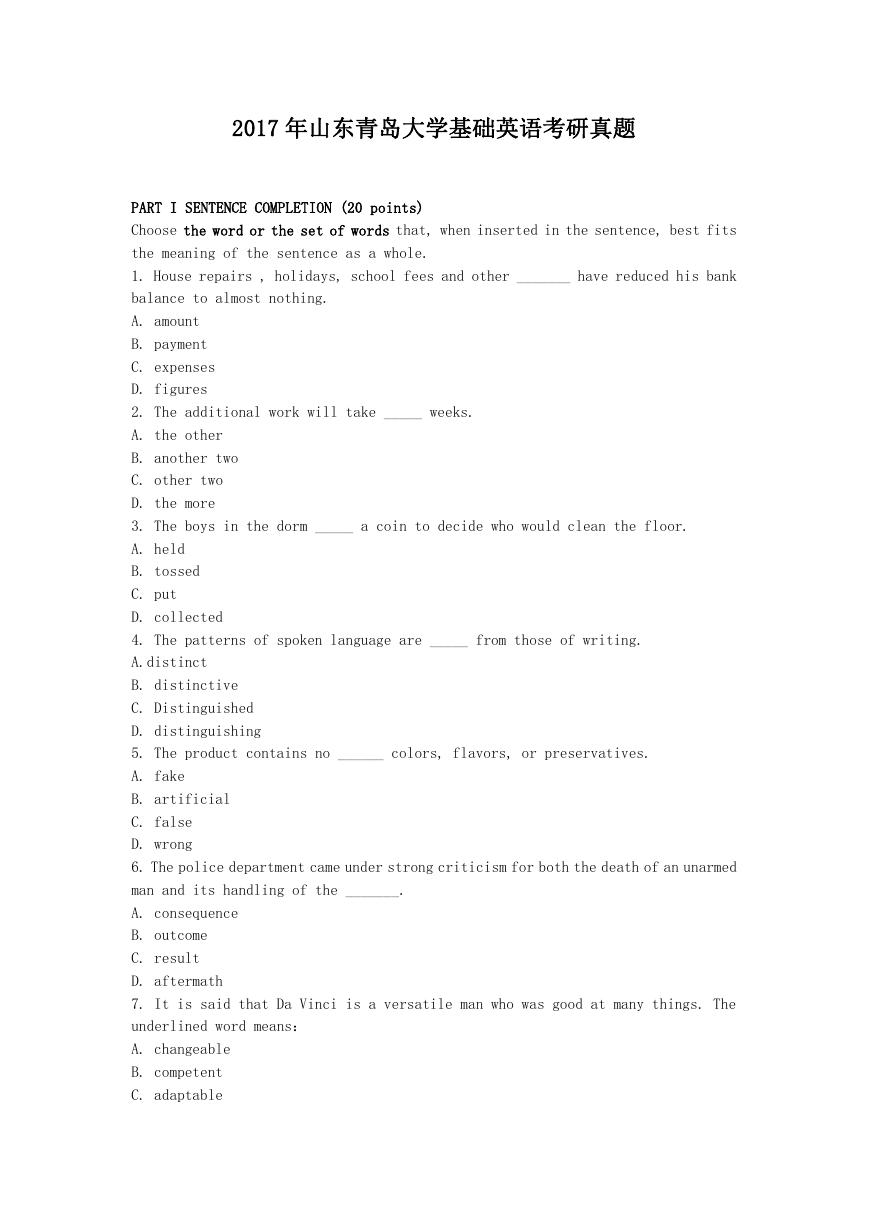
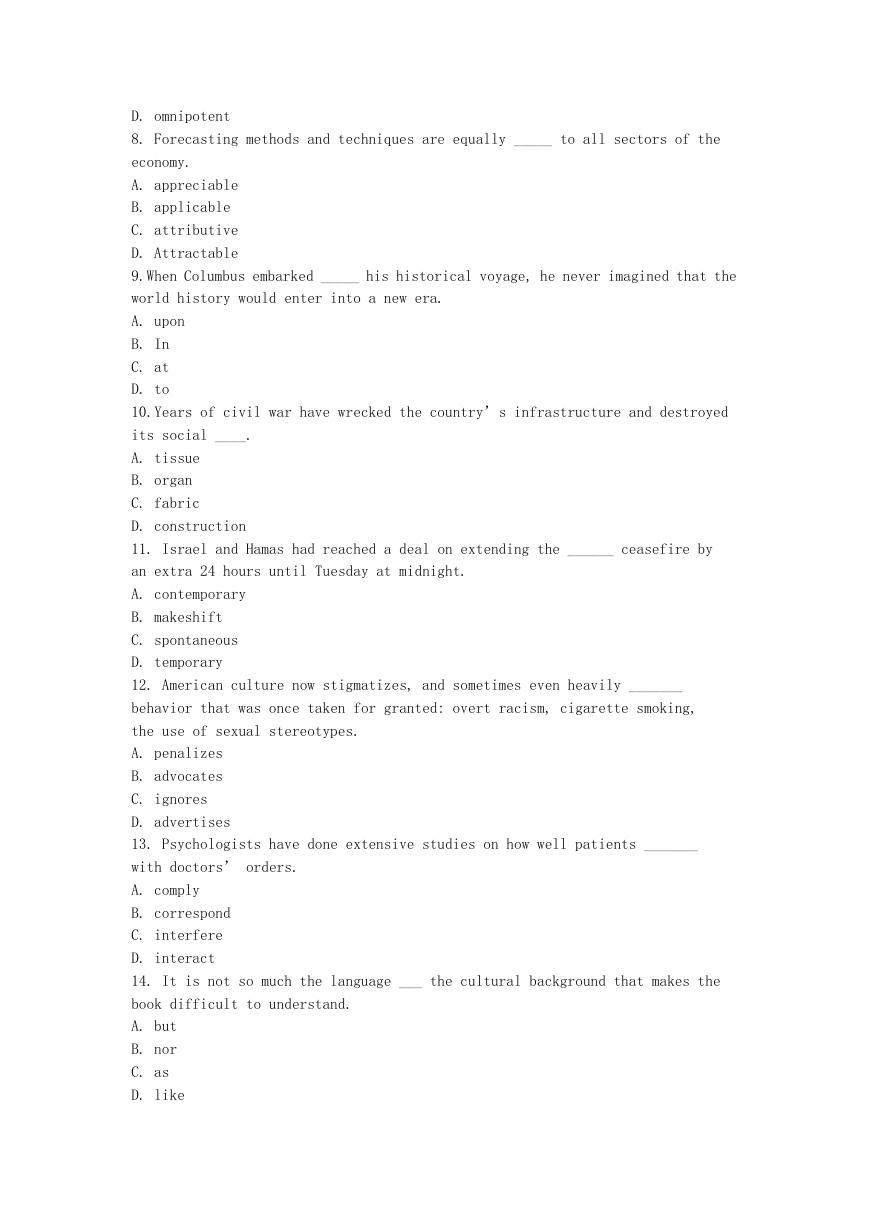

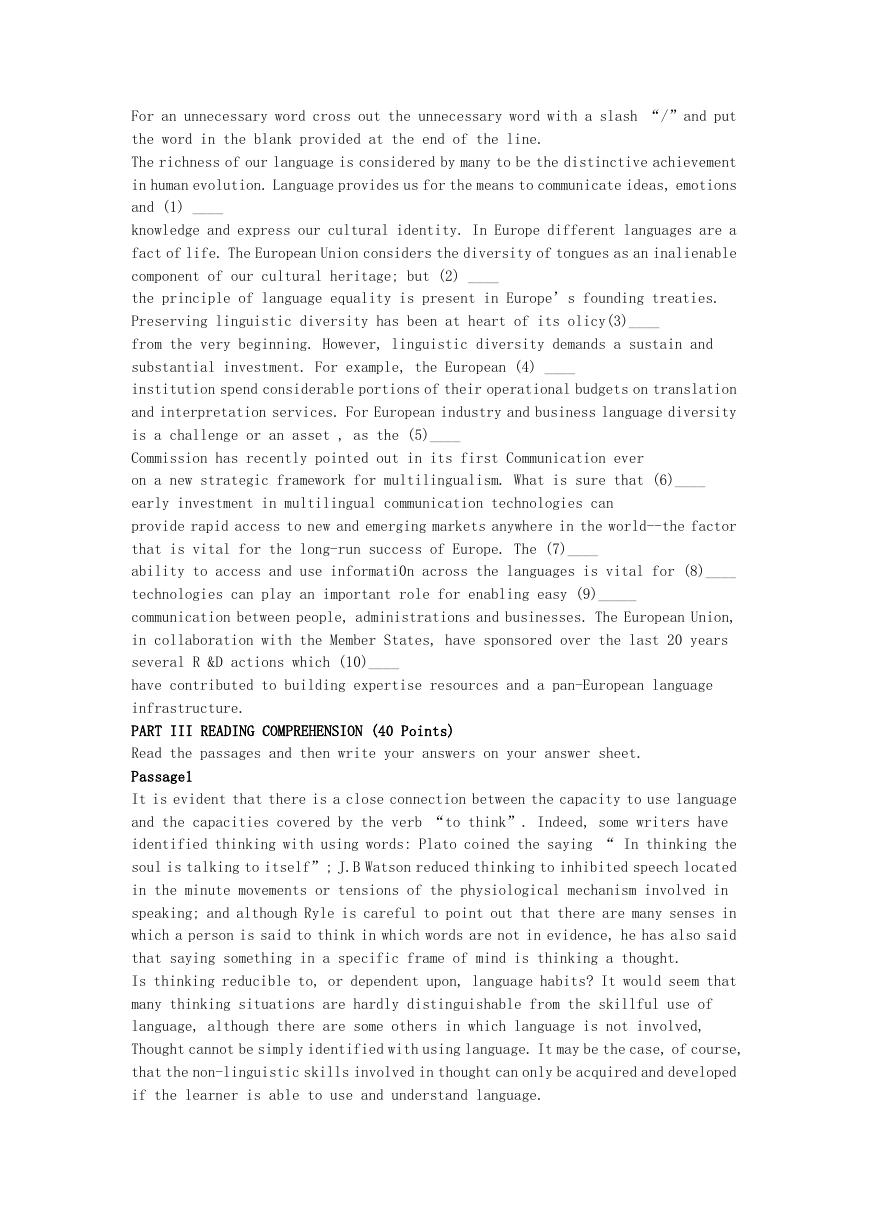
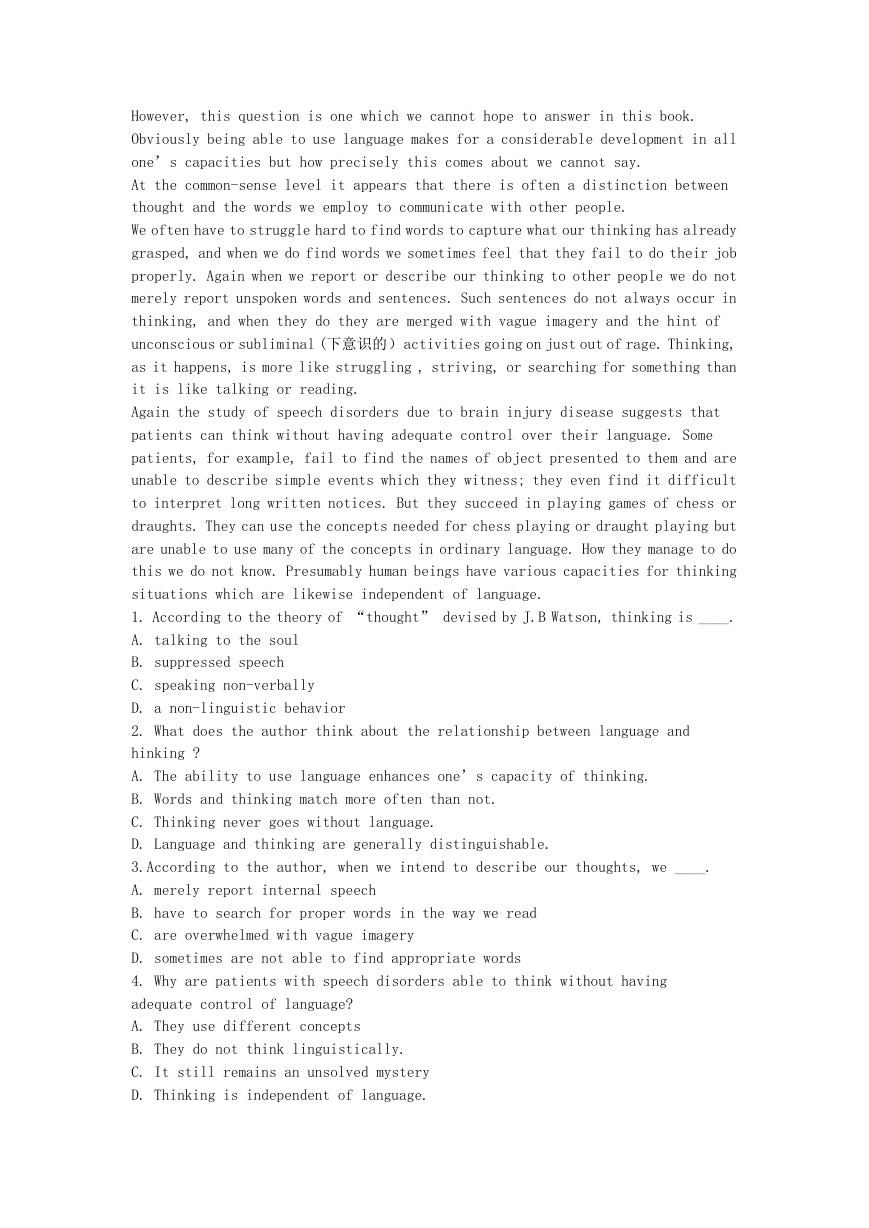
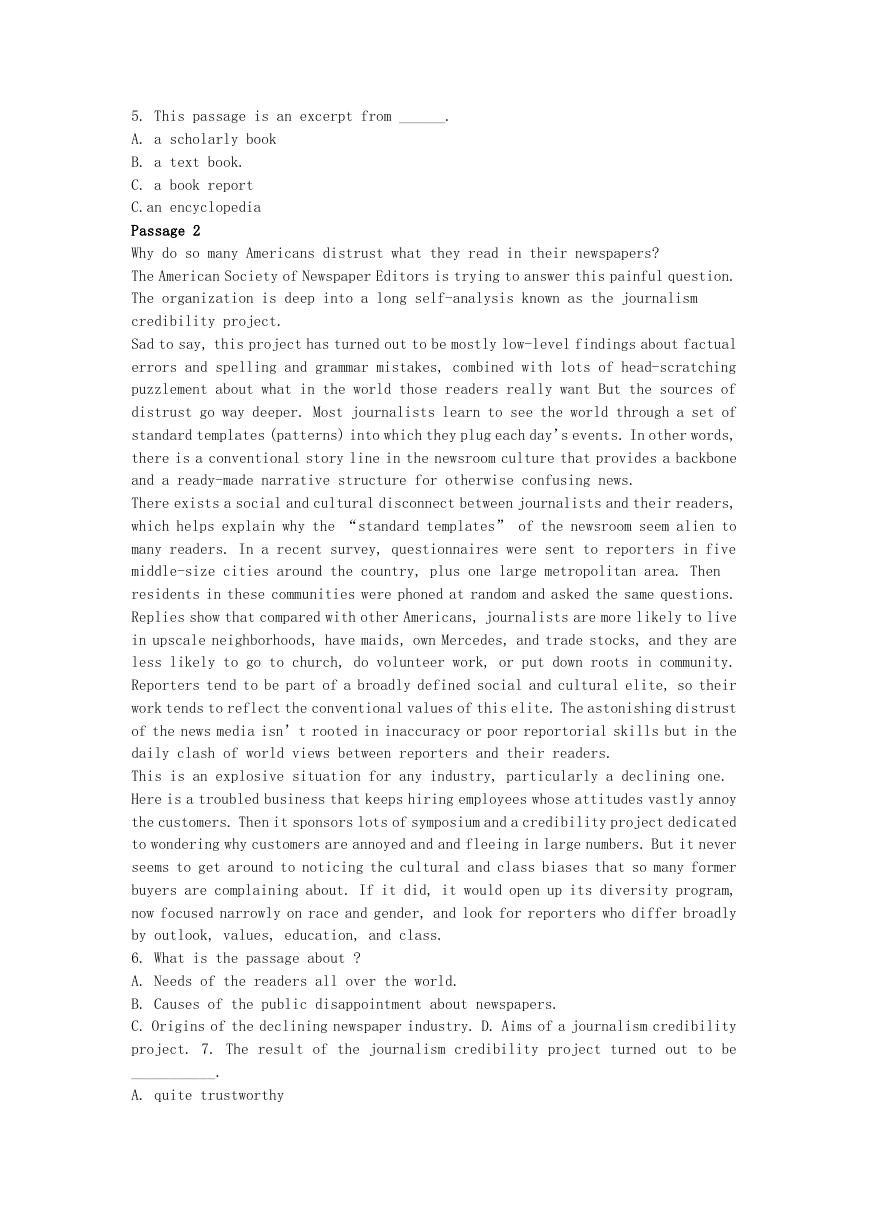
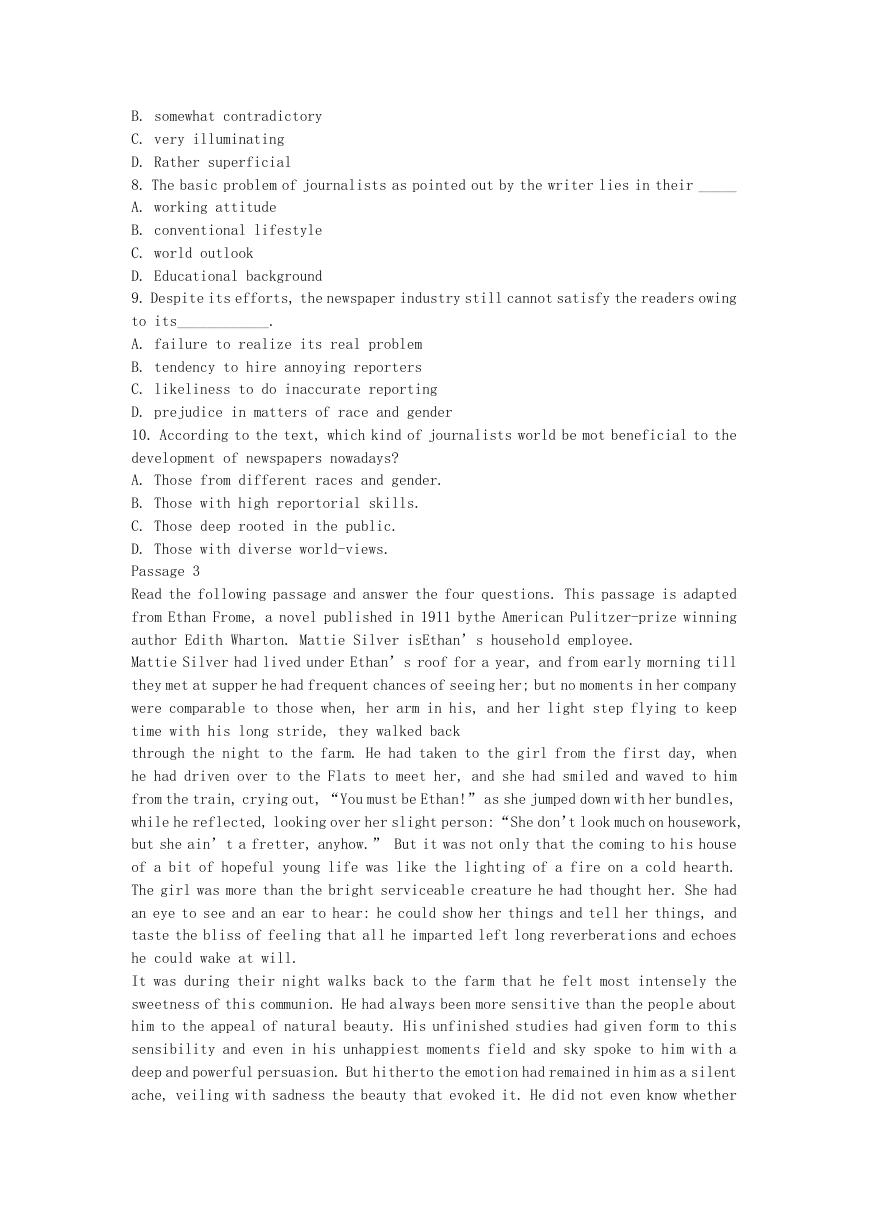
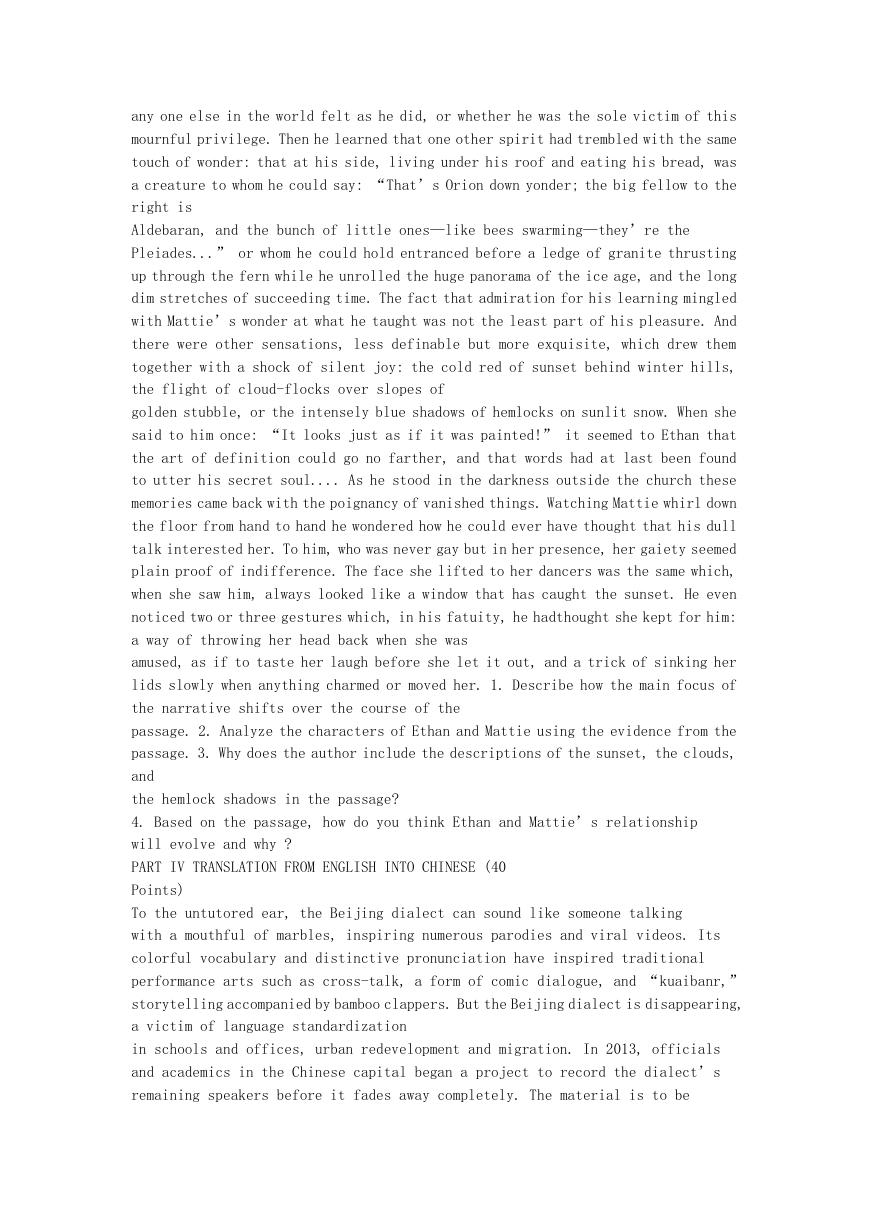








 2023年江西萍乡中考道德与法治真题及答案.doc
2023年江西萍乡中考道德与法治真题及答案.doc 2012年重庆南川中考生物真题及答案.doc
2012年重庆南川中考生物真题及答案.doc 2013年江西师范大学地理学综合及文艺理论基础考研真题.doc
2013年江西师范大学地理学综合及文艺理论基础考研真题.doc 2020年四川甘孜小升初语文真题及答案I卷.doc
2020年四川甘孜小升初语文真题及答案I卷.doc 2020年注册岩土工程师专业基础考试真题及答案.doc
2020年注册岩土工程师专业基础考试真题及答案.doc 2023-2024学年福建省厦门市九年级上学期数学月考试题及答案.doc
2023-2024学年福建省厦门市九年级上学期数学月考试题及答案.doc 2021-2022学年辽宁省沈阳市大东区九年级上学期语文期末试题及答案.doc
2021-2022学年辽宁省沈阳市大东区九年级上学期语文期末试题及答案.doc 2022-2023学年北京东城区初三第一学期物理期末试卷及答案.doc
2022-2023学年北京东城区初三第一学期物理期末试卷及答案.doc 2018上半年江西教师资格初中地理学科知识与教学能力真题及答案.doc
2018上半年江西教师资格初中地理学科知识与教学能力真题及答案.doc 2012年河北国家公务员申论考试真题及答案-省级.doc
2012年河北国家公务员申论考试真题及答案-省级.doc 2020-2021学年江苏省扬州市江都区邵樊片九年级上学期数学第一次质量检测试题及答案.doc
2020-2021学年江苏省扬州市江都区邵樊片九年级上学期数学第一次质量检测试题及答案.doc 2022下半年黑龙江教师资格证中学综合素质真题及答案.doc
2022下半年黑龙江教师资格证中学综合素质真题及答案.doc